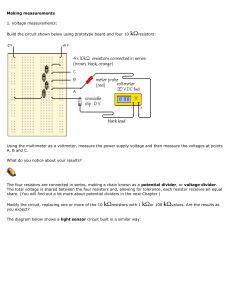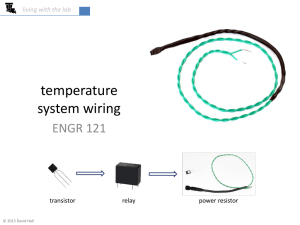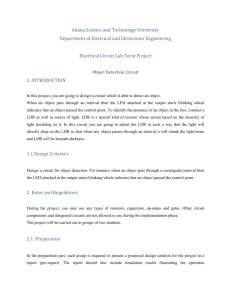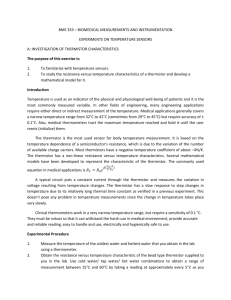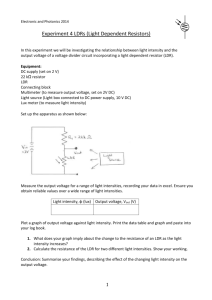Thermistor and LDR
advertisement
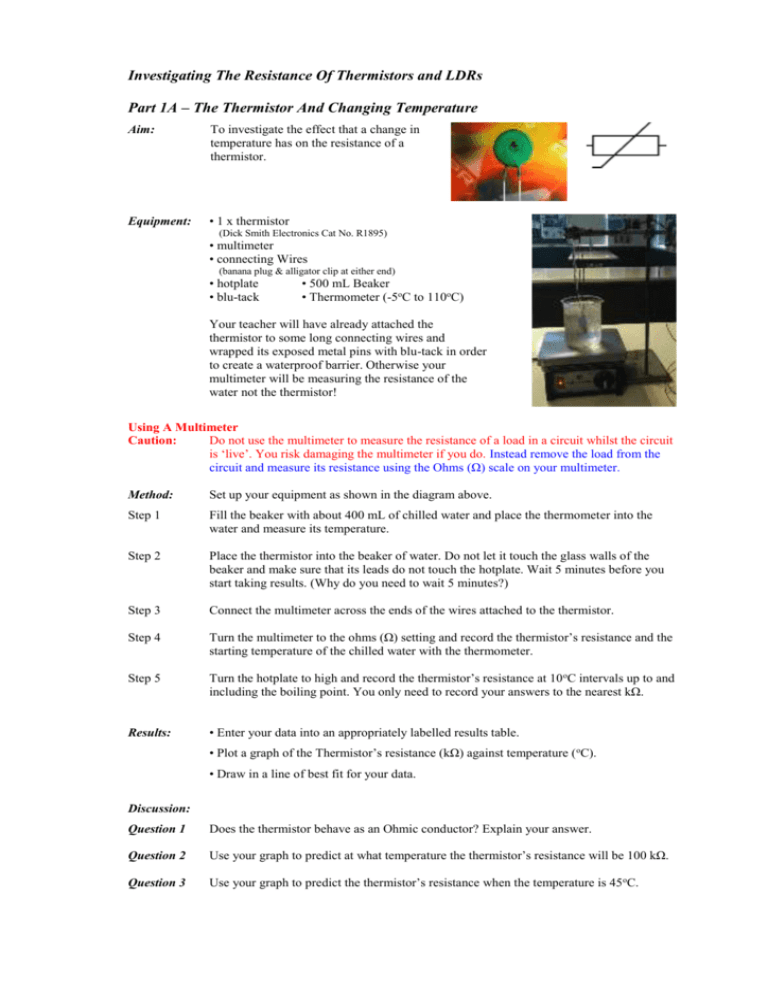
Investigating The Resistance Of Thermistors and LDRs Part 1A – The Thermistor And Changing Temperature Aim: To investigate the effect that a change in temperature has on the resistance of a thermistor. Equipment: • 1 x thermistor (Dick Smith Electronics Cat No. R1895) • multimeter • connecting Wires (banana plug & alligator clip at either end) • hotplate • blu-tack • 500 mL Beaker • Thermometer (-5oC to 110oC) Your teacher will have already attached the thermistor to some long connecting wires and wrapped its exposed metal pins with blu-tack in order to create a waterproof barrier. Otherwise your multimeter will be measuring the resistance of the water not the thermistor! Using A Multimeter Caution: Do not use the multimeter to measure the resistance of a load in a circuit whilst the circuit is ‘live’. You risk damaging the multimeter if you do. Instead remove the load from the circuit and measure its resistance using the Ohms (Ω) scale on your multimeter. Method: Set up your equipment as shown in the diagram above. Step 1 Fill the beaker with about 400 mL of chilled water and place the thermometer into the water and measure its temperature. Step 2 Place the thermistor into the beaker of water. Do not let it touch the glass walls of the beaker and make sure that its leads do not touch the hotplate. Wait 5 minutes before you start taking results. (Why do you need to wait 5 minutes?) Step 3 Connect the multimeter across the ends of the wires attached to the thermistor. Step 4 Turn the multimeter to the ohms (Ω) setting and record the thermistor’s resistance and the starting temperature of the chilled water with the thermometer. Step 5 Turn the hotplate to high and record the thermistor’s resistance at 10 oC intervals up to and including the boiling point. You only need to record your answers to the nearest kΩ. Results: • Enter your data into an appropriately labelled results table. • Plot a graph of the Thermistor’s resistance (kΩ) against temperature ( oC). • Draw in a line of best fit for your data. Discussion: Question 1 Does the thermistor behave as an Ohmic conductor? Explain your answer. Question 2 Use your graph to predict at what temperature the thermistor’s resistance will be 100 kΩ. Question 3 Use your graph to predict the thermistor’s resistance when the temperature is 45 oC. Part 1B – The Thermistor And Constant Temperature Aim: To investigate the effect that changing the potential difference across, and the current flowing through, a thermistor has on its resistance when at a constant temperature. Apparatus: • 2x multimeter, or 1 voltmeter and 1 ammeter • 1 x 10kΩ resistor • 1 x thermistor (Dick Smith Electronics Cat No. R1895) • connecting Wires Caution: Do not use the multimeter to measure the resistance of a load in a circuit whilst the circuit is ‘live’. You risk damaging the multimeter if you do. Instead remove the load from the circuit and measure its resistance using the Ohms (Ω) scale on your multimeter. Method: In the space provided below draw a circuit that shows the thermistor and the 10kΩ resistor connected in series with a 12V variable power supply. Include in your diagram an ammeter and voltmeter so that they can be used to measure the current flowing through, and potential difference across the thermistor. Remember to use a ruler when drawing your circuit diagram. Step 1 Measure and record the room’s temperature. Step 2 Measure and record the resistance of the thermistor as you did in Part 1A. Step 3 Using the appropriate pieces of equipment set up the circuit you designed so that you can measure the current flowing through, and the potential difference across the thermistor. Step 4 Set the variable power supply to 2V and record the current flowing through, and the potential difference across the thermistor. Repeat this process for settings on the power supply of 4, 6, 8, 10 and 12V. Results: • Enter your data into an appropriately labelled results table. • Use the data you have collected, and the definition of resistance, to calculate the thermistor’s resistance for each of the settings on the variable power supply. Discussion: Question 1 Based on your results and calculations, does the resistance of the thermistor change when it is at a constant temperature but the potential difference across it and current flowing through it change? Conclusion: Use a summary of your results to the two parts of this experiment to summarise what you have learned about thermistors. Part 2A – The Light Dependent Resistor (LDR) and Changing Light Intensity Aim: To investigate the resistance of an LDR as the intensity of the incident light on it changes. Equipment: • 1 x Light Dependent Resistor (LDR) (Dick Smith Electronics Cat No. Z4801) • torch or Hodson light box • 6 x primary red filters from the Hodson light box kits • blu-tack • empty 35 mm opaque film canister • multimeter • connecting wires (banana plug & alligator clip at either end) Your teacher will have already placed the LDR inside the film canister with a hole drilled in the bottom to let light in for you. Using A Multimeter Caution: Do not use the multimeter to measure the resistance of a load in a circuit whilst the circuit is ‘live’. You risk damaging the multimeter if you do. Instead remove the load from the circuit and measure its resistance using the Ohms (Ω) scale on your multimeter. Method: Set up your equipment as shown in the diagram above. Use blu-tack to hold the film canister and torch in place. Step 1 Connect the multimeter across the ends of the wires of the LDR. Step 2 Place the torch (Hodson light box) about 20 – 25 cm from the LDR. Step 3 Turn the torch (Hodson light box) on. Direct the light so that it shines through the hole in the bottom of the film canister and onto the LDR. Place one of the primary red filters against the end of the torch. This represents the initial intensity, I o, of your light source. Step 4 Record the resistance of the LDR for this initial intensity, I o. Step 5 Place each additional primary red filter in front of the torch and record the LDR’s resistance. This will give you six data points that you can plot. Results: • Enter your data into an appropriately labelled results table. • Plot a graph of the LDR’s resistance (kΩ) against Intensity, I, (number of filters from 0 to 5). • Draw in a line of best fit for your data. Discussion: Question 1 Does the LDR behave as an ohmic conductor? Explain your answer. Part 2B – The Light Dependent Resistor (LDR) and Constant Light Intensity Aim: To investigate the resistance of an LDR as the intensity of the incident light on it changes. Equipment: • 1 x Light Dependent Resistor (LDR) (Dick Smith Electronics Cat No. Z4801) • 1 x 10kΩ resistor • torch or Hodson light box • 1 x primary red filters from the Hodson light box kits • blu-tack • empty 35 mm opaque film canister • 2x multimeter, or 1 voltmeter and 1 ammeter • connecting wires Caution: Do not use the multimeter to measure the resistance of a load in a circuit whilst the circuit is ‘live’. You risk damaging the multimeter if you do. Instead remove the load from the circuit and measure its resistance using the Ohms (Ω) scale on your multimeter. Method: In the space provided below draw a circuit that shows the LDR and the 10kΩ resistor connected in series with a 12V variable power supply. Include in your diagram an ammeter and voltmeter so that they can be used to measure the current flowing through, and potential difference across the LDR. Remember to use a ruler when drawing your circuit diagram. Step 1 Connect the multimeter across the ends of the wires of the LDR. Step 2 Place the torch (Hodson light box) about 20 – 25 cm from the LDR. Step 3 Turn the torch (Hodson light box) on. Direct the light so that it shines through the hole in the bottom of the film canister and onto the LDR. Place one of the primary red filters against the end of the torch. This represents the initial intensity, I o, of your light source. Step 4 Record the resistance of the LDR for this initial intensity, I o. Step 5 Using the appropriate pieces of equipment set up the circuit you designed so that you can measure the current flowing through, and the potential difference across the LDR. Step 4 Set the variable power supply to 2V and record the current flowing through, and the potential difference across the LDR. Repeat this process for settings on the power supply of 4, 6, 8, 10 and 12V. Results: • Enter your data into an appropriately labelled results table. • Use the data you have collected, and the definition of resistance, to calculate the LDR’s resistance for each of the settings on the variable power supply. Discussion: Question 1 Based on your results and calculations, does the resistance of the LDR change when the intensity of light falling on it is constant but the potential difference across it and current flowing through it change? Conclusion: Use a summary of your results to the two parts of this experiment to summarise what you have learned about LDR’s. Resistor Colour Code Chart Dick Smith Electronics Thermistor http://www.dse.co.nz/dse.filereader?4d40d3f90073fcde2742c0a87f3b071c+EN/catalogs/SUP1000077 Light Dependent Resistor LDR http://www.dse.co.nz/dse.shop/4d40d3f90073fcde2742c0a87f3b071c/Export/catalogs/SUP1000072

